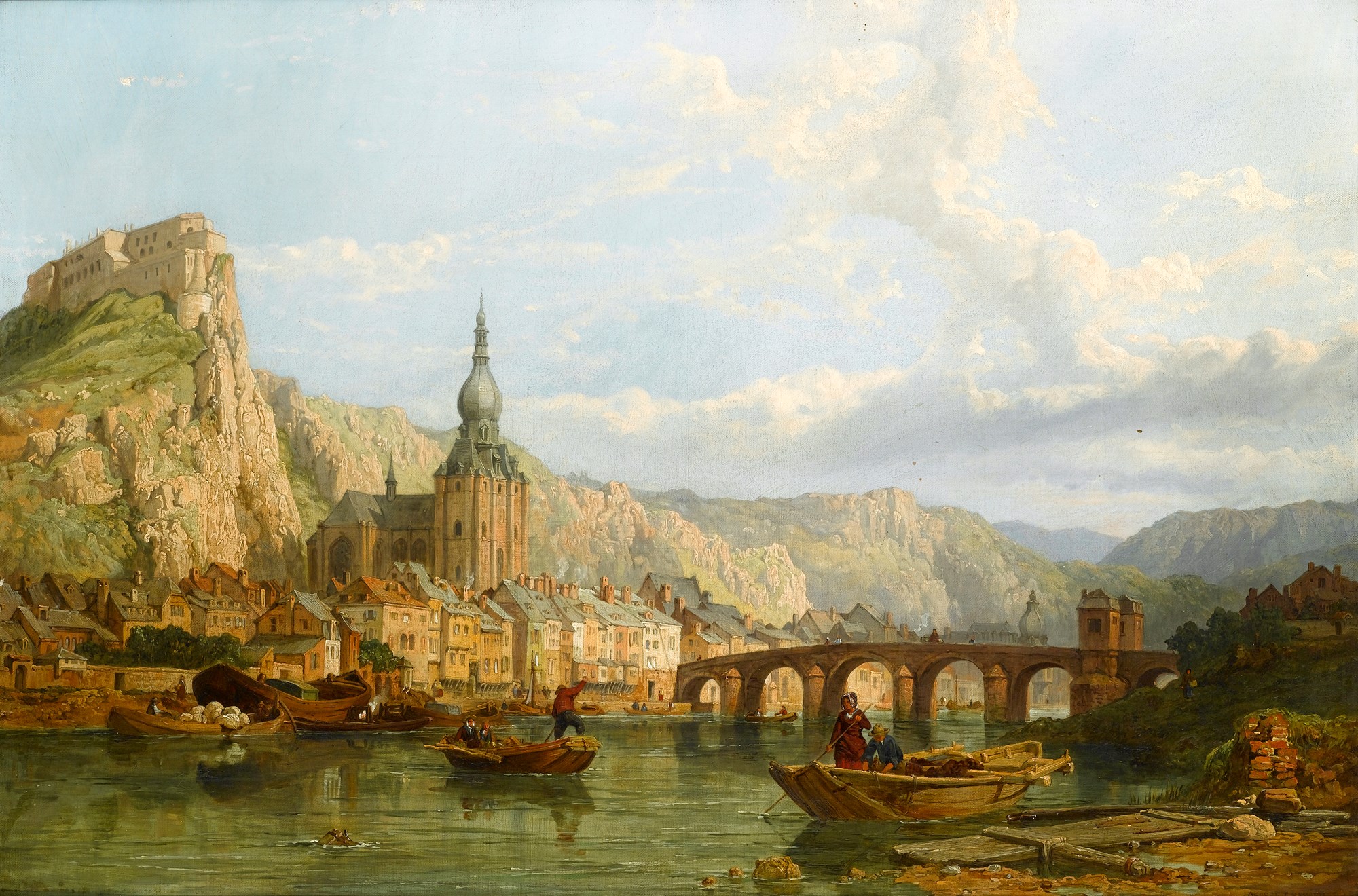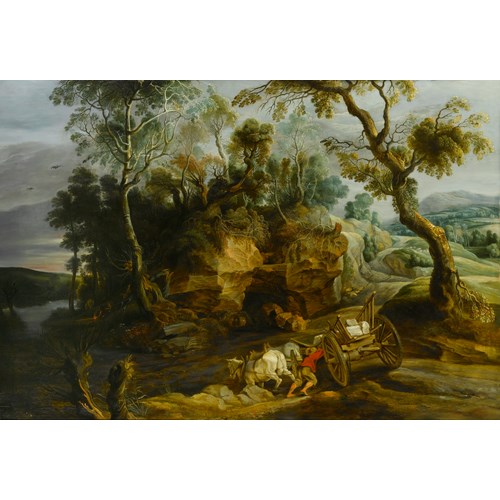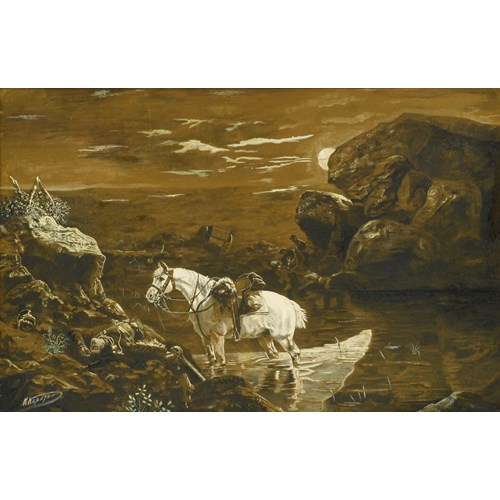Marketplace
A View of Dinant, Belgium
George Clarkson Stanfield
A View of Dinant, Belgium
Date 1860s
Period 1850-1900, 19th century
Origin England
Medium Oil on canvas
Dimension 50 x 74 cm (19⁵/₈ x 29¹/₈ inches)
In this work, George Clarkson Stanfield has captured the stunning beauty of the Belgian town of Dinant. In the foreground, figures ferry their passengers across the width of the River Meuse. The viewer’s eye moves from this foreground activity, along the water and to the town itself. Dominated by the towering onion-dome of the cathedral, the town rises proudly above the surrounding buildings, the strong vertical of the cathedral echoed behind it by the sharply rising and jutting cliff, atop of which sits a fortified citadel. Stanfield has captured the town’s sense of timelessness as it sits nestled under the monumental, weathered bulk of the cliffs, and the bright sunshine, which floods the scene and reflects off the calm surface of the river, enhancing the spectacular beauty of the city.
The first mentions of Dinant as a settlement date from the seventh century, although the city started to flourish during the eleventh century. Due to its position on the River Meuse, the city has often been seen as a key strategic point in the region’s conflicts, and as a result has frequently been caught-up in battles, from the middle-ages through to the First World War, when the bridge which Stanfield has painted in the present work was destroyed. Building work on the spectacular Gothic Collegiate Church of Notre-Dame began in 1227, after falling rocks from the cliffs destroyed the previous church. The distinctive, bulbous shape of the spire continues to dominate the surrounding landscape today. Although the citadel was first built in the eleventh century, it has frequently been destroyed and rebuilt throughout its history, and Charles de Gaulle (1890-1970) was injured there during the First World War: one of many battles to have taken place high on those cliffs. Despite its bloody history Dinant is still recognisable as the same spectacular city which captured Stanfield’s imagination in the present work.
Following the example of his famous father, Clarkson Frederick Stanfield, George Stanfield depicted many of the great European towns and cities, particularly those along the Meuse, the Rhine and throughout Italy. He painted Dinant on at least one other occasion,¹ and many of his other European views are comparable to A View of Dinant, Belgium, including Namur, (Private Collection) another city on the Meuse. In both works Stanfield moves the viewer’s eye from some foreground figures, across the expanse of water, to a spectacular, but topographically accurate, representation of the city. It is the type of simple and effective composition which his father used to such great effect in his work.
Born in London in 1828, Stanfield’s work is often overshadowed by and confused with that of his father, despite the younger artist having had a narrower range of subject matter. He first exhibited at the Royal Academy at the age of sixteen, and continued to do so throughout his life, establishing an extremely successful career with landscape and coastal scenes, of which the present work is a fine example.
¹ Sold at Christie’s, South Kensington, 13th March 1997, British and Victorian Pictures, lot 161.
The first mentions of Dinant as a settlement date from the seventh century, although the city started to flourish during the eleventh century. Due to its position on the River Meuse, the city has often been seen as a key strategic point in the region’s conflicts, and as a result has frequently been caught-up in battles, from the middle-ages through to the First World War, when the bridge which Stanfield has painted in the present work was destroyed. Building work on the spectacular Gothic Collegiate Church of Notre-Dame began in 1227, after falling rocks from the cliffs destroyed the previous church. The distinctive, bulbous shape of the spire continues to dominate the surrounding landscape today. Although the citadel was first built in the eleventh century, it has frequently been destroyed and rebuilt throughout its history, and Charles de Gaulle (1890-1970) was injured there during the First World War: one of many battles to have taken place high on those cliffs. Despite its bloody history Dinant is still recognisable as the same spectacular city which captured Stanfield’s imagination in the present work.
Following the example of his famous father, Clarkson Frederick Stanfield, George Stanfield depicted many of the great European towns and cities, particularly those along the Meuse, the Rhine and throughout Italy. He painted Dinant on at least one other occasion,¹ and many of his other European views are comparable to A View of Dinant, Belgium, including Namur, (Private Collection) another city on the Meuse. In both works Stanfield moves the viewer’s eye from some foreground figures, across the expanse of water, to a spectacular, but topographically accurate, representation of the city. It is the type of simple and effective composition which his father used to such great effect in his work.
Born in London in 1828, Stanfield’s work is often overshadowed by and confused with that of his father, despite the younger artist having had a narrower range of subject matter. He first exhibited at the Royal Academy at the age of sixteen, and continued to do so throughout his life, establishing an extremely successful career with landscape and coastal scenes, of which the present work is a fine example.
¹ Sold at Christie’s, South Kensington, 13th March 1997, British and Victorian Pictures, lot 161.
Date: 1860s
Period: 1850-1900, 19th century
Origin: England
Medium: Oil on canvas
Signature: Signed and dated ‘GEORGE. C STANFIELD 186*’ (lower right).
Dimension: 50 x 74 cm (19⁵/₈ x 29¹/₈ inches)
More artworks from the Gallery




-Baumgartner-Stoiloff-Running from the Wolves_T637903807484877285.jpg?width=500&height=500&mode=pad&scale=both&qlt=90&format=jpg)




